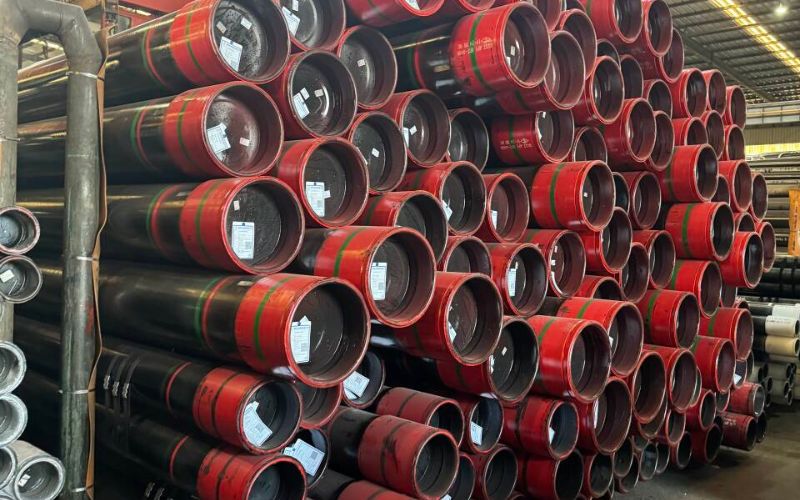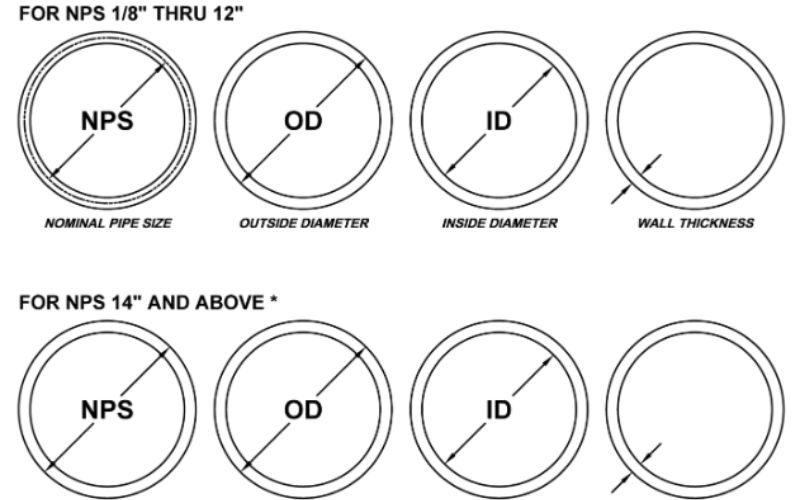When industrial and residential piping projects come into play, it becomes imperative to choose the materials that will provide for durability, functionality, and cost-effectiveness. Among so many kinds of pipes, the 3-inch black iron pipe presents itself as a dependable and versatile option. The following guide thoroughly explains the 3-inch black iron pipe, its basic features, some typical applications, and important considerations for installation and maintenance. Whether you are a contractor, an engineer, or a handy-person, this article will equip you with the knowledge to make informed decisions and further enhance your projects.
Understanding Black Iron Pipe
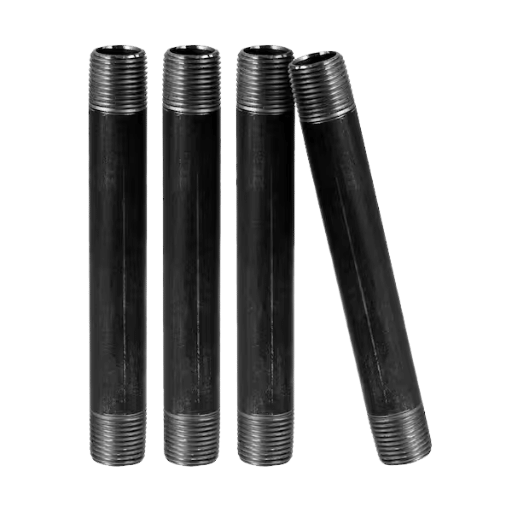
Black iron pipe, considered to be durable and versatile, is commonly produced from low-grade mild steel. This type of pipe is characterized by an iron-oxide coating that appears dark-colored and forms naturally during the manufacturing process. Unlike galvanized pipes, black iron pipes retain no protective zinc coating, so water transport is not hindered by corrosion. When they go into natural gas, propane, or fire sprinkler systems, they are favored because of their strength and heat resistance. Pipes are available in varied lengths and diameters suitable for residential and commercial installation.
What is a Black Iron Pipe?
A black iron pipe is a steel pipe, created raw from iron, uncoated. It was usually used for transporting natural gas or propane and fire sprinklers, withstanding maximum temperatures for durability. It has no zinc coating, though, unlike galvanized pipes, so it can easily get corroded when exposed to rain or moisture. Typically, one will find black iron pipe stock in many lengths and diameters to suit various residential and commercial applications.
Types of Black Iron Pipes
The black iron pipe can be differentiated by its thickness and usage. The two primary types include:
Standard Weight Pipe (Schedule 40)
Being the most commonly used black iron pipe, it permits general-purpose usage, such as for natural gas and propane or gas distribution.
Heavy-Duty Pipe (Schedule 80)
Built for systems of higher pressure, this one has thicker walls that give it additional life. It is usually found in industrial settings or where heavy-duty work is required, such as with schedule 80 carbon steel pipe.
Specifications and Schedules
Black iron pipes are differentiated by standard schedules, indicating the wall thickness and pressure rating. The two standard schedules are:
- Schedule 40
Standard-weight piping applicable for low to medium-pressure systems should be reliable for most residential and commercial applications such as gas distribution and water systems, especially when connections are made using pipe nipples. - Schedule 80
Traversed by thick walls for higher-pressure applications. This schedule is about industrial plants or installations requiring a higher strength and durability, particularly when the plain carbon steel pipe type is used.
Note: Each pipe schedule is assigned to fit against pressure or operation demand, with development being the support for pipe selection for various systems. The pipe schedule is not itself a substitute for proper referencing to standards and codes for ensuring compliance with system requirements.
Applications of 3 Inch Black Steel Pipe
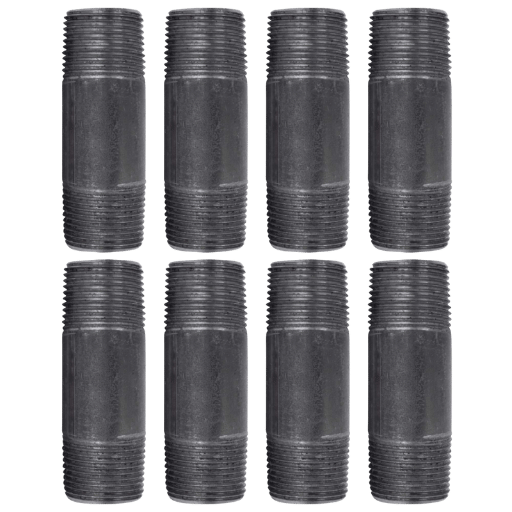
Industrial Uses
3-inch black steel pipes are widely used in multiple industries given their durability, tensile strength, and wear resistance properties. Gas, oil, and steam make their way through pipelines in energy and utility systems. These pipes are part of power plants and refineries and are subjected to varying extremes of temperatures and pressures.
In manufacturing plants, black steel pipes may be used for hydraulic and pneumatic systems, carrying either compressed air or liquids to operate heavy machinery. The corrosion-resistant abilities of these pipes, when combined with an appropriate protective coating, make them ideal for environments where moisture or chemicals may be present. Structural uses can also be made of them, and per standards, these include the erection of building frameworks, scaffolding, and load-bearing structures that will perform reliably over many years.
Heating Systems
Heating systems nowadays have seen significant advancements in making them more efficient, reliable, and sustainable. The integration of innovative technology is one advancement, where one can monitor and control heating systems remotely. As per newer energy efficiency studies, installing smart thermostats can cut heating energy consumption by 10-12%, thus saving costs and benefiting the environment in homes where carbon steel pipe is used for heating systems.
In the heating technology arena, emerging renewable energy sources have an influential effect. Heat pumps, especially air-source and ground-source ones, have lately been a rising star as they give highly efficient alternatives to conventional heating by gas or oil. Modern heat pumps are said to have an efficiency rating of more than 300 percent, as they transfer heat as opposed to generating it; thus, they are well-suited for systems constructed of ordinary carbon steel pipe.
Installation Tips for Black Iron Pipes
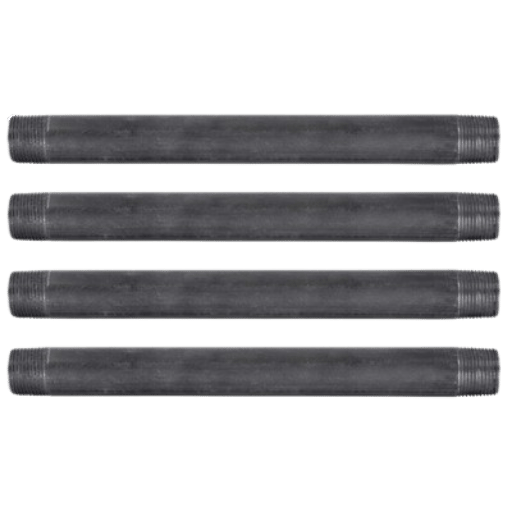
Preparation and Planning
Proper preparation and planning constitute a successful installation of black iron pipes. Before carrying out the installation itself, measure and mark the pipeline layout as accurately as possible. This never allows for any waste of materials. Make sure that all tools and materials required for the work are at hand: pipe cutters, thread sealant, wrenches, suitable fittings, and carbon steel pipe.
Check both pipes and fittings for visible defects, such as cracks or dents, before installation. Studies show that nonconforming or misaligned components compromise the efficiency and safety of the system. Lastly, ensure the working area is free of dust and debris, as contaminants can interfere with proper connections and cause leaks.
Important: Make the best-of-choice by thoroughly consulting the local codes and safety regulations relating to the use of pipe systems. Some standards that come readily to mind are those set by the American Society of Mechanical Engineers (ASME) and the International Code Council (ICC). Following such guidelines assures the integrity of the system but also adds to the life expectancy of the pipe installation.
Necessary Tools and Materials
Good pipe installation requires a well-chosen set of tools and materials to get the job done efficiently and up to the industry standards. The following list covers all pertinent items:
🔧 Tools
- Pipe Cutters – For clean, precise cuts
- Wrenches – Adjustable, pipe, and torque wrenches
- Tube Benders – For shaping metal pipes
- Inspection Cameras – For interior assessments
- Threading Machines – For pipe threading
- Deburring Tools – For smoothing edges
📦 Materials
- Pipes – Various materials based on requirements
- Fittings – Elbows, tees, couplings, flanges
- Sealants & Gaskets – Teflon tape, compounds
- Fasteners – Anchors, brackets, clamps
- Valves – For flow regulation
Step-by-Step Installation Guide
Installation Process
Step 1: Preparing the Workspace
Ensure that the workspace is clean and that the environment is conducive to installation. Check to confirm that all tools, components, and safety equipment are available. Ensure at least three feet of clearance in the installation space for the safe movement of equipment and materials.
Step 2: Inspecting Materials and Tools
Before the start of installation, verify all materials, such as pipes, fittings, and connectors, for any damage, such as cracks or any other irregularities. Carry out precision measurement of all components to ensure their adherence to the specifications outlined in the project plan or engineering standards.
Step 3: Cutting and Measuring Pipes
Measure pipe segments with perfection if the system layout is being considered using a calibrated tape measure. Cut the pipe with either a pipe cutter or with a saw suitable for the particular materials to have smooth, clean edges. Deburr the edges with a deburring tool to remove any rough places that may prove to be hindrances during the joining.
Step 4: Fitting and Alignment
Position the pipes and fittings carefully and according to the project diagrams, ensuring exact positioning. Use a level or laser alignment tool to verify that the system is perfectly oriented and free from misalignments that could have adverse effects on flow efficiency and state of integrity.
Step 5: Securing Connections
Assemble the components together with an adhesive or sealant fit for the pipe materials being joined or weld the pipes, based on the specific types of pipes being joined. Use either thread sealant tape or thread sealant on the metal threads to avoid leaks. Use torque wrenches to tighten flushes; this prevents the chance of overtightening that may destroy the item.
Step 6: Pressure Testing
After assembly, do a pressure test to ensure that the system remains leak-free and retains the strength given for operational pressure in the specification. Use a pressure gauge calibrated for testing; slowly pressurize up to the pressure required to test between anomalies. If any leak or weakness is detected, isolate the problem and repair, then retest.
Step 7: Final Inspection and Handover
Carry out a thorough inspection of the system as installed to ensure its compliance with project specifications and requirements—document all recorded measurements, test results, and observations for future reference. After the verification, clean the work area and hand it over to the client or team for maintenance. Appropriate system documentation and operating procedures should also be provided.
Maintenance Best Practices
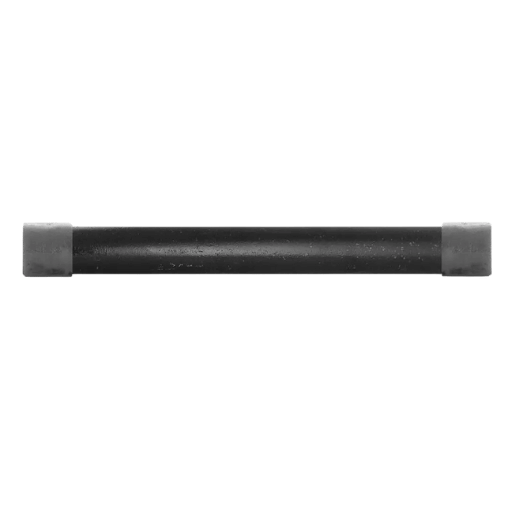
Routine Inspection and Cleaning
Regular maintenance ensures the systems perform at optimal levels, have a long life, and do not face sudden shutdowns that could lead to losses. The key steps in routine inspection and cleaning would be:
- Visual Inspections: Conducting periodic inspections for signs of wear, damage, or corrosion on any of the components. Check for loose connections or cracks, or anything out of the ordinary that might impact functionality.
- Cleaning Procedures: Dirt, dust, and other debris slowly reduce efficiency during the very long hours of operation. Depending upon the materials and systems involved, cleaning tools and agents must be selected to clean without causing damage.
- Component Testing: Measuring the parameters, such as voltage, pressure, or flow rate, under operational conditions can expose anomalies. Actually measured values must be taken using calibrated instruments and cross-checked with the specifications given by the manufacturer.
- Lubrication and Adjustments: For mechanical systems, inspect moving components and apply the recommended lubricant to prevent unnecessary friction and wear. Adjust alignment and tension settings as needed to maintain smooth operation.
- Filter and Vent Cleaning: Clogged filters or vents can restrict airflow and lower efficiency. Replace or clean filters regularly and ensure ventilation is unobstructed for good performance.
- Documentation: Keep an exhaustive record of all inspection results, cleaning, or corrective actions taken. Being equipped with comparative data historically can provide predictive input into maintenance and possible upgrading of the system.
Common Maintenance Issues
⚠️ Clogged Filters and Ductwork
One of the common issues in maintenance is debris accumulation in filters and ductwork. Study shows that clogged filters can reduce efficiency up to 15% which in turn causes undue stress to the system. Regular inspections and cleaning must be scheduled to ensure proper air flow and energy efficiency.
🔧 Wear and Tear on Mechanical Components
With time, belts, bearings, and other mechanical components wear away until they become torn and have equipment failures. This is especially the case where carbon steel pipe is in use. Bad bearings, for instance, reduce motor efficiency and can also make a lot of noise. Predictive maintenance, such as vibration analysis, can address such problems before they become serious.
💧 Refrigerant Leaks
Refrigerant line leakage not only diminishes cooling capacity but also increases power consumption. Operating cost data shows that a slight refrigerant loss of 10% results in a 20% increase in operating costs. Leak detection methods and sealing techniques should be put in place to avoid this most common issue.
🛡️ Corrosion and System Aging
In metal equipment exposed to moisture and temperature variations, corrosion is something to be concerned about. Corrosion would cause leakage, destabilize the structures, or cause malfunctions in the equipment. Using corrosion-resistant materials after timely inspections can go a long way towards preventing these problems.
📡 Sensor Malfunctions
A faulty sensor will give false readings that will disrupt the performance and efficiency of the systems. It is essential to calibrate the sensors periodically for proper functioning. The reliability of sensors acquires further significance in automated systems, where incorrect data could have a significant impact on the operation.
Long-term Care for Black Iron Pipes
Maintenance for black iron pipes is critically essential for their durability and long-lasting performance. These pipes are best utilized for the transportation of gases and other industrial applications because of their strength and resistance to high pressure. However, if not maintained adequately, these pipes become rusty and corroded. The protective coating of oil or paint may be a barrier against moisture and oxygen, a significant cause of corrosion.
Periodic inspections should be carried out to spot any wear, leakage, or rust in the system. When rust is found, surface rust removal, such as sanding or wire brushing, should be applied before further damage sets in. Also, fittings and joints should be tested for tightness because a loose fitting may cause gas leaks, compromising system performance.
Humidity control is another key factor in the long-term care of black iron pipes, particularly in enclosed areas. Dehumidifiers or adequate ventilation serve to limit moisture build-up, hence prolonging the life of these pipes. For systems handling gas, however, it is considered paramount to ensure that the pipe-work meets all industry standards and safety regulations to forestall accidents and preserve operational safety.
Industry Insight: According to studies and industry insights, the life expectancy of black iron pipes in the field can be pushed considerably beyond the normal fifty to one hundred years, depending on environmental conditions and dimensions of use, if subjected to regular maintenance and preventative intervention.
Comparison with Other Piping Materials
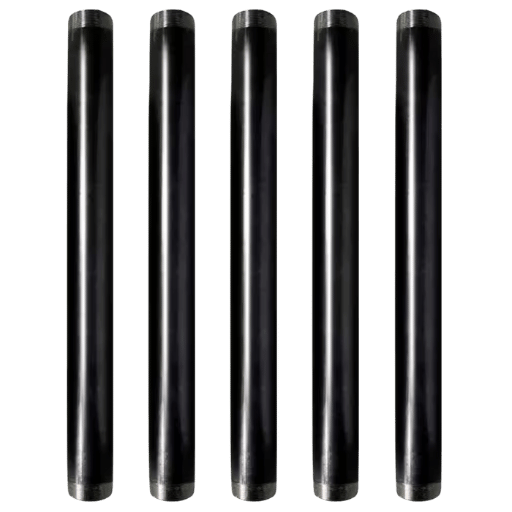
Black Steel vs. Galvanized Steel
| Parameter | Black Steel | Galvanized Steel |
|---|---|---|
| Coating | None | Zinc |
| Color | Black | Silver-gray |
| Corrosion | Prone | Resistant |
| Durability | Moderate | High |
| Cost | Cheaper | Expensive |
| Applications | Gas transport | Water systems |
| Maintenance | Low | Minimal |
| Lifespan | Shorter | Longer |
| Strength | High | Moderate |
| Environment | Indoor | Outdoor |
Black Iron vs. PVC Pipes
| Parameter | Black Iron | PVC |
|---|---|---|
| Durability | High, prone to rust | Long-lasting, no rust |
| Cost | Expensive | Affordable |
| Installation | Labor-intensive | Easy |
| Weight | Heavy | Lightweight |
| Fire Resistance | Excellent | Moderate |
| Noise | Quieter | Louder |
| Flexibility | Brittle | Flexible |
| Heat Sensitivity | Low | High |
| Water Flow | More friction | Smoother flow |
Advantages and Disadvantages of Black Iron Pipes

✅ Advantages
Strength and Durability
Black iron pipes are recognized for their high strength, allowing them to be put to work on high-pressure service, such as gas and steam distribution. Being rigid ensures they have a long period of service life, mainly in industrial and commercial applications where strong materials are required.
High Heat Resistance
With their high resistance to fire, black iron pipes may sustain extremely high temperatures without suffering a loss in structural integrity, hence being fit to carry hot gases and liquids and for use in fire sprinkler systems.
Cost-Effective for Gas Applications
Although installation costs are higher compared to other pipes, these pipes might be cheaper when installed in gas transportation systems, as they adequately resist pressure and damage for an extended period of time.
Low Noise Levels
Their solid and dense composition restrains vibration and noise, therefore being considered a noisier alternative than PVC.
❌ Disadvantages
Prone to Corrosion
One of the major drawbacks of black iron pipes is that they are prone to rust and corrosion, especially if moisture is present for a long time. This can limit their service life and call for protective coatings or regular maintenance.
Heavy and Labor-Intensive Installation
Heavy in nature, black iron pipes need specialized tools as well as skilled persons for cutting, threading, and installation. Hence, the installation becomes a tough and time-consuming process when compared to a PVC pipe.
Limited Application in Water Systems
As it has a rusty disposition, the black iron pipe is generally not used in water transfer systems. This can lead to contamination and a decrease in the water quality.
Brittleness Under Certain Conditions
While strong, black iron pipes can be brittle, particularly in extreme cold conditions, where they may crack or fail under impact.
Higher Long-Term Costs in Corrosive Environments
Maintenance and possible replacement in corrosive environments will cause the overall cost to go higher than when using corrosion-resistant materials like stainless steel or PVC.
Important Note: By weighing these advantages and disadvantages, engineers and contractors can make informed decisions about the suitability of black iron pipes for specific projects or applications.
Frequently Asked Questions (FAQs)
Q: What is the description of a 3-inch black pipe?
A: A 3-inch black pipe is usually constructed of carbon steel and employed for various applications, such as gas and water lines. It meets the requirements for durability and corrosion resistance, which allow these pipes to be used indoors or outdoors.
Q: What is the price range for schedule 40 black pipe?
A: Schedule 40 black pipe price depends on its length, diameter, and seller. Usually, it can cost a few dollars a foot to even more, depending on the market situation and exact requirement.
Q: What are the common sizes of black iron pipe fittings?
A: Black iron pipe fittings come in sizes ranging from 1/2 inch, 1 inch, 2 inches, to the highly demanded 3-inch design for larger piping systems.
Q: What is the difference between schedule 40 and schedule 80 black pipe?
A: Schedule 40 black pipes are relatively thinner in their wall thickness, whereas Schedule 80 black pipes are comparatively thicker in wall thickness. So wall thickness helps determine the pressure rating and overall strength, with having schedules of 80 set for higher-pressure applications.
Q: How do I connect a 3-inch black pipe to other pipes or fittings?
A: There are several ways to connect a 3-inch black pipe to other pipes or fittings, including threading, welding, or attaching flanges. Depending on the specific application and pressure requirements, consider whichever method is deemed appropriate.
Q: What is black malleable iron pipe used for gas supply?
A: Black malleable iron pipe is best suited for gas supply because it is strong and holds up well under high pressure. It is used in residential and commercial gas systems, ensuring safe and reliable distribution of gas.
Q: Can I use pre-cut lengths of black iron pipe for my DIY projects?
A: Yes, lengths of black-iron pipe that have been cut down are great for any DIY job. They work perfectly for making shelves, railings, or similar items, allowing easy assembly with only the use of simple unions-an application that does not involve cutting or extensive fitting.
Q: What are the pipe schedule specifications for 3-inch black iron pipe?
A: The pipe schedule specifications for 3-inch black iron pipe are usually schedule 40 and schedule 80. Schedule numbers are indications of wall thickness and pressure rating of the pipe, factors important in the determination of application and safety of the pipe.
Q: How does corrosion affect the lifetimes of black pipe?
A: The corrosion significantly affects the lifetimes of black pipe. It tends to rot after exposure to moisture and some corrosive elements, so frequent maintenance and inspection remain a key consideration to ensure the integrity of the piping system.
Reference Sources
- University of Maryland: Laboratory Piping Systems – This document talks about specifications of steel pipes such as ASTM specifications for black steel pipes.
- Brown University: HVAC Pipes and Tubes – It details black steel pipes and fittings used in HVAC systems.
- Pipe (fluid conveyance)
- Black Steel Pipe Supplier In China
Ready to Start Your Project?
Black iron pipes remain a trusted choice across various industries and use cases. With proper installation, maintenance, and care, these pipes provide reliable performance for decades. Whether you’re working on industrial applications, heating systems, or gas distribution, understanding the characteristics and requirements of 3-inch black iron pipe will help ensure project success.



